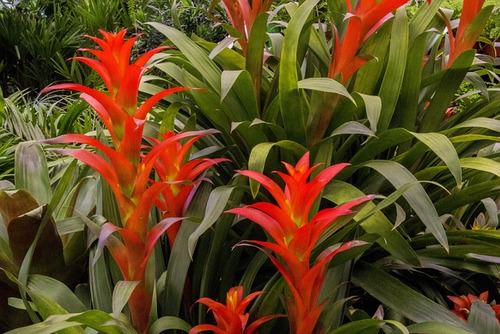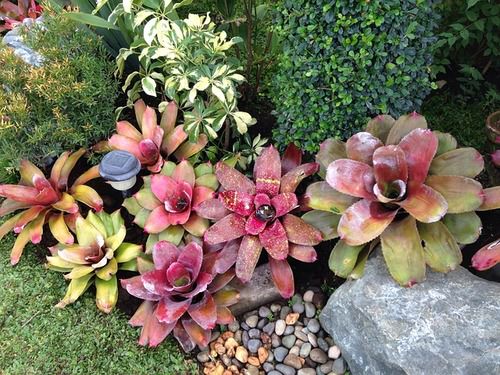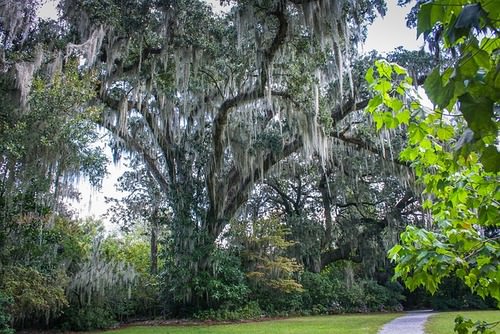13.55 Epipphite - 高级
章节大纲
-
Epiphytes: Creating New Niches Above the Ground
::Pipphites: 在地面上创造新尼斯Epi - means “upon” and phyte means “plant”, so an epiphyte could be any plant, lichen , , , or growing on or attached to a living plant. However, the term usually refers only to seed plants which remain autotrophic and obtain moisture from the atmosphere . Parasites such as mistletoe are not considered “true” epiphytes. By some estimates, about 10% of and seed plants - and half of all orchid - are epiphytes. Most epiphytes live in or rainforests, where humidity and for sunlight are high. What are the benefits of an epiphytic niche which does not allow harm to the host ?
::Epi 是指“被”和植物是指“植物”,因此,一个附着植物可以是任何植物、地衣、或生长在或附着在活植物上或附着在活植物上,但是,这个词通常只指保持自养和从大气中获得水分的种子植物,象寄生虫这样的寄生虫不被认为是“真正的”附着物。据某些人估计,大约10%的植物和种子植物——以及所有兰花的一半——是附着物。大多数附着植物或雨林中生活着着着,那里的湿度和阳光都很高。一个不会伤害宿主的附着性地方有什么好处呢?-
The host plant provides support.
::东道工厂提供支助。 -
Often, support includes elevation toward more sunlight. Only 1-2% of incident sunlight reaches the rainforest floor.
::通常,支持包括向更多的阳光升空。 只有1-2%的事故阳光到达雨林层。 -
Aboveground locations reduce access by some
herbivores
.
::地面上的一些地方减少了一些食草动物的接触。 -
Elevation may increase the success of wind- or insect-
pollination
.
::升高可能会增加风污染或昆虫污染的成功率。
Stretching the limits of this definition, several infamous species eventually exploit “free” access to sunlight by overgrowing their hosts. Strangler figs and New Zealand rātās ( Figure ) begin their lives as epiphytes, sprouting from seeds dropped by into crevices of a host tree. Young plants send branches upward to the sunlight zone, and grow down the host trunk to and nutrients in the ground. Over decades (for figs) or centuries (for rātās), the “supercanopy” and “pseudotrunk” may result in the death of the host tree, and the former epiphyte becomes a free-standing tree. The largest is a 250-year-old Bengal Fig or Banyan tree, whose original trunk has died but which continues to spread beyond its current 2800 aerial roots and 14478.44 square metres (over 3½ acres). Apparently, biologists judge this level of dependency and harm to be excessive; although all epiphytes depend on their hosts for support and a “boost” to sunlight, strangler figs and New Zealand rātās are considered hemiphytes , or hemi-epiphytes, rather than true epiphytes.
::几个臭名昭著的物种最终利用“免费”的阳光,过度扩张了它们的宿主。 斯特拉格勒无花果和新西兰赖特克(Figure)开始作为附生植物,从从树苗中掉落的种子发芽到宿主树的裂缝中。 年轻的植物将树枝向上移到阳光区,从宿主的树干到地面上生长,并养分。 数十年来(对于无花果)或几百年来(对于ratās ) , “ 超大树”和“假树”都可能导致宿主树死亡,而以前的附着植物则成为一棵独立树。 最大的树是250年前的孟加拉福特或班尼扬树,其原始树树已经枯萎缩,但仍在目前的2800个空中根和14478.44平方米(超过31⁄2英亩)以上。 显然,生物学家判断这种依赖和伤害的程度是过度的;尽管所有附着动物都依赖于宿主的宿主对阳光、扼制的雕塑和新西兰的宗教是真实的。Hemiphytes such as strangler figs begin life as epiphytes, but then acquire easy access to canopy sunlight and use the energy to completely overgrow their host tree. Roots growing down to the ground eventually establish them as independent trees, sometimes surrounding an empty chamber where the host has decayed. Some true epiphytes are called “air plants;” and this description could be applied to all. What adaptations allow a tree to begin its life in air rather than soil ? Clearly, air lacks the abundance and steady supply of nutrients and water found in most soils. You will not be surprised that epiphytes share many characteristics with , but in addition, epiphytes have adaptations related to nutrient acquisition.
::一些真正的附着植物被称为“空气植物 ” , 这个描述可以适用于所有人。 什么样的适应允许树在空气中而不是土壤中开始生命? 显然,空气缺乏大部分土壤中发现的丰富和稳定的营养和水供应。 你并不感到惊讶的是,附着植物有许多与养分相关的特性,但是,附着植物也有与养分获取有关的适应。Epiphytes can acquire water only from humidity in the air, dew, rain, or the damp surface of the host. Rain may bring a surprising abundance of nutrients; a study in Brazilian rainforests found that annual rainfall brought 3kg of phosphorus, 2 kg of iron, and 10 kg of nitrogen to a single hectare of land. However, many epiphytes have developed specialized adaptations to collect and hold moisture and additional nutrients.
::对巴西雨林进行的一项研究发现,每年的降雨量将3千克磷、2千克铁和10千克氮带到一公顷土地,然而,许多附生植物已经开发出专门的适应方法来收集和保持湿度和更多的营养物。-
The leaves of “tank bromeliads” (
Figure
) are rolled into a watertight funnel - a “tank” or “urn” to hold water. Rain and plant debris fall into the pool, and absorbing
tissue
at the leaf base plays the role of root, taking in both water and nutrients. The largest of these holds over 8 liters (2 gallons) of water. These mini-
support numerous
and
, providing a relatively predator-free environment. The plant benefits, too, by absorbing nutrients from the wastes of the
.
::雨水和植物碎片落到水池中,在叶子底部吸收组织的作用是根,同时吸收水和养分,其中最大的含水量超过8升(2加仑)的水,这些微型支持数量众多,提供了相对无掠食性的环境,植物也通过吸收废物的养分而受益。
Tank bromeliads collect rainwater – over to 8 liters (2 gallons) in the largest species – in funneled leaves. Fleshy tissue at the bottom of the “tank” absorbs water and nutrients, the latter made more plentiful by amphibians and arthropods who complete entire lifecycles in the pools. -
Many epiphytes form “traps” with foliage or roots to catch falling leaf or other litter. Elkhorn fern, for example, protects its roots and traps falling leaves to feed them with a basal
frond
quite different from the curled forked fronds which give the fern its name.
::许多附生植物形成“陷阱 ” , 用树叶或根根来捕捉落的叶子或其他垃圾。 比如,Elkhorn Fearn保护其根部和树叶,用树枝和树叶来喂养它们。 树枝和树枝与弯曲的叉子非常不同,它给产卵者起名。
Elkhorn fern, named for the shape of its fronds, has in addition a basal frond which protects the roots and traps leaves and other detritus between the roots and host tree. This “compost pile” also holds water. -
In Spanish
Moss
– neither a moss nor a lichen - and other members of the bromeliad
genus
Tillandsia
, roots are absent, but a highly modified, scale- (or
trichome
-) covered shoot absorbs moisture from the atmosphere.
::在西班牙摩斯 — — 既不是苔类,也不是地衣 — — 以及布罗米利亚人种蒂兰德西亚的其他成员中,没有根根,但是一个经过高度修改的、规模(或家庭)覆盖的镜头吸收了大气中的湿度。
Spanish moss has consists of highly modified shoots covered with scales or trichomes, which help absorb moisture from the air. The rust-colored seed pod shows that this “moss” is actually a flowering plant. -
Epiphytic orchids grow large aerial roots covered with a tough layer of dead
, the
velamen
, which absorbs atmospheric humidity when it is available, and shrivels to prevent water loss when it is not. Full of water, this covering becomes transparent, allowing light to reach interior photosynthetic tissue.
::植物性兰花在空气中长出巨大的根根根,上面覆盖着坚硬的一层死尸,即吸收大气湿度的花生,如果有的话,会吸收大气湿度,如果不吸收,也会挤压以防止水流失。 满是水,这种覆盖会变得透明,让光线能够到达内部的光合作组织。
-
Some species have symbiotic relationships with bacteria which fix nitrogen from the air, or mycorrhizal fungi which aid the
absorption
of other
micronutrients
.
::有些物种与从空气中修补氮的细菌或有助于吸收其他微量营养素的细微菌有共生关系。
As “perched” plants, all epiphytes must solve the problem of attachment. Epiphyte roots often take advantage of a vegetation mat formed by lichens, mosses and other . These plants trap airborne dust and litter, create “canopy compost”, and begin the formation of soil much as they do in rocky habitats . Plants such as Elkhorn fern add to this aerial humus. Roots may anchor in and absorb water and nutrients from this soil, but in true epiphytes, they do not penetrate or absorb from host tissue.
::作为“固定的”植物,所有附着植物都必须解决附着问题。 食用植物根往往利用由地衣、苔和其他植物形成的植被垫。 这些植物捕捉空气中的灰尘和垃圾,创造“冠状堆肥 ” , 并像在岩石生境一样开始形成土壤。 像Elkhorn Fern这样的植物会增加这种空中的。 根可能固定和吸收来自这一土壤的水和养分,但是在真正的附着植物中,它们不会从宿主组织中渗透或吸收。Most epiphytes depend on wind for seed dispersal . Small size and wind-adapted structures such as parachutes carry these seeds aloft and increase the chance that they will lodge in bark crevices or tree branches to begin new epiphytic lives. Some form elaborate relationships with birds or other animals for dispersal. Perhaps most intriguing are mistletoe berries (although, as stated above, they are parasitic rather than true epiphytes). A laxative substance coats the berries, carrying them swiftly through the digestive tracts of birds. Other chemicals may cause the seeds to stick to the tail feathers of birds as they are excreted; eventually, they are rubbed off on branches, which are ideal habitat for new growth.
::大部分附生植物依赖风来散布种子。小尺寸和适应风力的结构,如降落伞等,携带着这些种子,并增加它们栖息在树枝或树枝中的机会,以开始新的附生生命。一些与鸟类或其他动物的复杂关系可以分散。也许最有趣的是寄生虫莓(尽管如上所述,它们是寄生虫,而不是真正的附生虫 ) 。 一种咸水物质涂上浆果,迅速通过鸟类的消化道携带它们。 其他化学物质可能使种子随着鸟类的排出而粘在尾部羽毛上;最终,它们被擦掉在树枝上,而树枝是新生长的理想栖息地。Summary
::摘要-
Epiphytes grow on top of or attached to other plants, gaining support but not nutrition from the host.
::食虫动物生长在其他植物之上或附属于其他植物,从宿主那里获得支持,但没有营养。 -
Hemiphytes may eventually overgrow and kill their host trees, with roots which grow down into the soil.
::希米菲植物最终可能长得过大并杀死其宿主树木,树根会长到土壤中。 -
Epiphytes share many adaptations with xerophytes.
::Epiphites 分享许多与xerophytes的适应。 -
Aerial roots, traps for rainfall and litter, and symbioses with bacteria and fungi characterize epiphytes.
::空中根,雨水和垃圾的陷阱, 以及细菌和真菌的共生关系, 以及昆虫的特征。
-
The host plant provides support.




